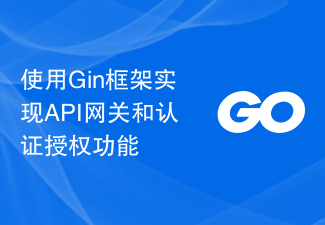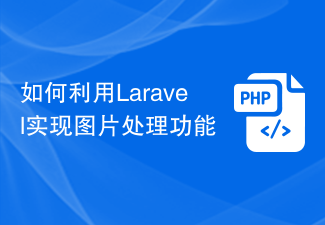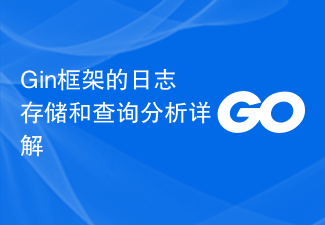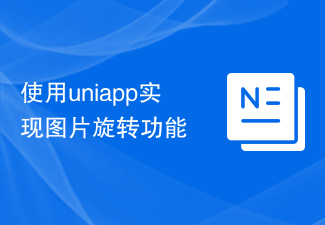With the continuous development of the Internet, there are more and more demands for Web applications. What followed was the need for real-time communication, and Websocket came into being. Gin is an efficient Web framework based on Golang. The Websocket communication function can be easily implemented through the Gin framework.
This article will introduce how to use the Gin framework to implement Websocket communication functions.
Install the Gin framework
Before you start using the Gin framework, you need to install the Gin framework first. It can be installed through the following command:
go get -u github.com/gin-gonic/gin
Create a Gin application
After installing the Gin framework, we can start creating a Gin application. Create a app.go file and implement it according to the following code:
package main
import (
"github.com/gin-gonic/gin"
)
func main() {
router := gin.Default()
router.GET("/ping", func(c *gin.Context) {
c.JSON(200, gin.H{
"message": "pong",
})
})
router.Run(":8080")
}The above code creates a Gin application, the listening port is 8080, and accesses http:// in the browser localhost:8080/ping will return a JSON response.
Use Gin framework to implement Websocket
Next, we will use Gin framework to implement Websocket communication function. We will create a websocket.go file and follow the following steps to implement it:
Import dependencies
Before starting, you need to import the following dependencies:
import (
"log"
"net/http"
"github.com/gorilla/websocket"
"github.com/gin-gonic/gin"
)Here we imported the Gin framework, Gorilla websocket library, and log and net/http in the Go standard library.
Define Gin routing
We define a Websocket route through the Gin framework:
router.GET("/ws", func(c *gin.Context) {
wsHandler(c.Writer, c.Request)
})Define Websocket processing function
We define a wsHandler Function, used to process Websocket connections:
var upgrader = websocket.Upgrader{
ReadBufferSize: 1024,
WriteBufferSize: 1024,
CheckOrigin: func(r *http.Request) bool {
return true
},
}
func wsHandler(w http.ResponseWriter, r *http.Request) {
conn, err := upgrader.Upgrade(w, r, nil)
if err != nil {
log.Println(err)
return
}
defer conn.Close()
for {
// 读取消息
_, msg, err := conn.ReadMessage()
if err != nil {
log.Println(err)
return
}
// 处理消息
log.Printf("收到消息: %s
", msg)
// 回复消息
err = conn.WriteMessage(websocket.TextMessage, []byte("已收到消息!"))
if err != nil {
log.Println(err)
return
}
}
} The above function upgrades the HTTP connection to a Websocket connection by calling the websocket.Upgrader method, and handles read and write operations in the Websocket connection. In the code, we first use the upgrader.Upgrade method to upgrade the HTTP connection to a Websocket connection. Then, in an infinite loop, use the conn.ReadMessage method to read the client's message data, print out the read message, and then use the conn.WriteMessage method to write a reply The message is returned to the client.
Websocket read and write operations are a blocking process, so they need to be performed in an infinite loop. The loop will exit when the client disconnects from the Websocket.
Test Websocket connection
After writing the above code, we can test the Websocket connection through the following steps:
- Start the Gin application:
go run app. go - Open the
http://localhost:8080/wspage in the browser - Open the browser's developer tools and execute the following in the console Code:
var websocket = new WebSocket("ws://localhost:8080/ws");
websocket.onopen = function(evt) {
console.log("连接成功!");
websocket.send("Hello WebSocket!");
};
websocket.onmessage = function(evt) {
console.log("收到消息:" + evt.data);
};
websocket.onclose = function(evt) {
console.log("连接已关闭!");
};In the above code, we use the WebSocket API to establish a connection with Websocket and send a message. When the connection to Websocket is successfully established, the console will output "Connection successful!"; when a reply message from Websocket is received, the console will output "Message received: Message received!"; when the connection is closed, the control The station will output "Connection closed!".
Summary
Through the above steps, we successfully implemented the Websocket communication function using the Gin framework. The Gin framework provides a rich API that allows us to easily carry out web development. Websocket is an important mechanism for realizing real-time communication. Through the combination of Gin framework and Websocket, we can develop Web applications with real-time communication functions more conveniently and quickly.
The above is the detailed content of Using Gin framework to implement Websocket communication function. For more information, please follow other related articles on the PHP Chinese website!
 使用Gin框架实现API网关和认证授权功能Jun 22, 2023 am 08:57 AM
使用Gin框架实现API网关和认证授权功能Jun 22, 2023 am 08:57 AM在现代化互联网架构中,API网关已经成为了重要的组成部分,被广泛应用于企业和云计算的场景中。API网关的主要作用是统一管理和分发多个微服务系统的API接口,提供访问控制和安全保护,同时也能够进行API文档管理、监控和日志记录等方面的工作。为了更好地保障API网关的安全和可扩展性,一些访问控制和认证授权的机制也被加入到了API网关中。这样的机制可以确保用户和服
 Gin框架的国际化处理和多语言支持详解Jun 22, 2023 am 10:06 AM
Gin框架的国际化处理和多语言支持详解Jun 22, 2023 am 10:06 AMGin框架是一种轻量级的Web框架,它的特点在于快速和灵活。对于需要支持多语言的应用程序来说,Gin框架可以很方便地进行国际化处理和多语言支持。本文将针对Gin框架的国际化处理和多语言支持进行详细阐述。国际化处理在开发过程中,为了兼顾不同语言的用户,很有必要对应用程序进行国际化处理。简单来讲,国际化处理就是对应用程序的资源文件、代码、文本等内容进行适当修改和
 如何利用Laravel实现图片处理功能Nov 04, 2023 pm 12:46 PM
如何利用Laravel实现图片处理功能Nov 04, 2023 pm 12:46 PM如何利用Laravel实现图片处理功能,需要具体代码示例现如今,随着互联网的发展,图片处理已经成为了网站开发中必不可少的一部分。Laravel是一个流行的PHP框架,为我们提供了很多便捷的工具来处理图片。本文将介绍如何利用Laravel实现图片处理功能,并给出具体的代码示例。安装LaravelInterventionImageInterven
 Gin框架的日志存储和查询分析详解Jun 22, 2023 am 08:22 AM
Gin框架的日志存储和查询分析详解Jun 22, 2023 am 08:22 AMGin框架是一款轻量级的Web框架,它的优点在于速度快、易用性高、功能强大,因此被越来越多的开发者所喜爱和使用。作为一个Web应用程序,它一定会产生大量的日志信息,为了更好地对这些日志进行存储和查询分析,我们需要对Gin框架的日志功能进行深入了解和应用。一、Gin框架的日志功能Gin框架提供了两种日志记录方式:分别是控制台输出和文件输出。通过设置Gin框架的
 Gin框架的Socket和TLS支持详解及其应用Jun 22, 2023 am 08:27 AM
Gin框架的Socket和TLS支持详解及其应用Jun 22, 2023 am 08:27 AMGin框架是一个轻量级的Web框架,它简单易用,高效快捷,并且支持Socket和TLS协议。本文将对Gin框架的Socket和TLS支持进行详解,并探讨它们在实际项目中的应用。一、Socket支持Socket概述Socket是一种通信协议,它能够在网络上传输数据。Socket是由IP地址和端口号组合而来的,它主要用于进程间的通信,从而实现网络应用的开发。Gi
 PHP开发:如何实现图片验证码功能Sep 20, 2023 pm 04:00 PM
PHP开发:如何实现图片验证码功能Sep 20, 2023 pm 04:00 PMPHP开发:如何实现图片验证码功能在WEB开发中,为了防止机器人或恶意攻击,常常需要使用验证码来验证用户的身份。其中,图片验证码是一种常见的验证码类型,既能有效识别用户,又能提升用户体验。本文将介绍如何使用PHP来实现图片验证码功能,并提供具体的代码示例。一、生成验证码图片首先,我们需要生成带有随机字符的验证码图片。PHP提供了GD库可以方便地生成图像。以下
 使用uniapp实现图片旋转功能Nov 21, 2023 am 11:58 AM
使用uniapp实现图片旋转功能Nov 21, 2023 am 11:58 AM使用uniapp实现图片旋转功能在移动应用开发中,经常遇到需要对图片进行旋转的场景,比如拍摄照片后需要进行调整角度,或者实现类似相机拍照后旋转的效果。本文将介绍如何使用uniapp框架实现图片旋转功能,并提供具体的代码示例。uniapp是一个基于Vue.js的跨平台开发框架,可以同时开发和发布iOS、Android、H5等多个平台的应用。在uniapp中实现
 如何使用WordPress插件实现即时查询功能Sep 06, 2023 pm 12:39 PM
如何使用WordPress插件实现即时查询功能Sep 06, 2023 pm 12:39 PM如何使用WordPress插件实现即时查询功能WordPress是一款功能强大的博客和网站建设平台,使用WordPress插件可以进一步扩展网站的功能。在很多情况下,用户需要进行实时查询来获取最新的数据。接下来,我们将介绍如何使用WordPress插件实现即时查询功能,并提供一些代码示例供参考。首先,我们需要选择一个适合的WordPress插件来实现即时查询


Hot AI Tools

Undresser.AI Undress
AI-powered app for creating realistic nude photos

AI Clothes Remover
Online AI tool for removing clothes from photos.

Undress AI Tool
Undress images for free

Clothoff.io
AI clothes remover

AI Hentai Generator
Generate AI Hentai for free.

Hot Article

Hot Tools

Safe Exam Browser
Safe Exam Browser is a secure browser environment for taking online exams securely. This software turns any computer into a secure workstation. It controls access to any utility and prevents students from using unauthorized resources.

SecLists
SecLists is the ultimate security tester's companion. It is a collection of various types of lists that are frequently used during security assessments, all in one place. SecLists helps make security testing more efficient and productive by conveniently providing all the lists a security tester might need. List types include usernames, passwords, URLs, fuzzing payloads, sensitive data patterns, web shells, and more. The tester can simply pull this repository onto a new test machine and he will have access to every type of list he needs.

SublimeText3 Mac version
God-level code editing software (SublimeText3)

ZendStudio 13.5.1 Mac
Powerful PHP integrated development environment

SublimeText3 English version
Recommended: Win version, supports code prompts!







